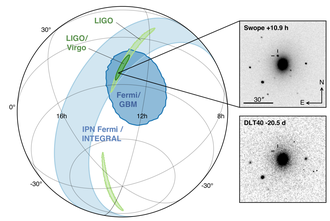
For the first time, scientists have directly detected gravitational waves — ripples in space and time — in addition to light from the spectacular collision of two neutron stars. This marks the first time that a cosmic event has been viewed in both gravitational waves and light.
The discovery was made using the U.S.-based Laser Interferometer Gravitational-Wave Observatory (LIGO); the Europe-based Virgo detector; and some 70 ground- and space-based observatories.
The image shows the localization of the gravitational-wave (from the LIGO-Virgo 3-detector global network), gamma-ray (by the Fermi and INTEGRAL satellites) and optical (the Swope discovery image) signals from the transient event detected on the 17th of August, 2017. The colored areas show the sky localization regions estimated by the gamma-ray observatories (in blue) and by the gravitational-wave detectors (in green). Rapid and precise localization by the global network of three gravitational-wave detectors - thanks to a fortunate position of Advanced Virgo with respect to the signal at the moment of detection - allowed for finding a new EM source and a very successful multi-messenger followup observations. The insert shows the location of the apparent known galaxy NGC4993: on the top image, recorded almost 11 hours after the gravitational-wave and gamma-ray signals had been detected, a new source (marked by a reticle) is visible: it was not there on the bottom picture, taken about three weeks before the event. (Credit: LIGO-VIRGO)
In addition to Polish Polgraw gravitational-wave data analysis and astrophysical modelling group working at CAMK (a member of the LIGO-Virgo collaboration), several projects involving Polish scientists working at CAMK currently or
collaborating with our institute took part in the multi-messenger observations of the event: Fermi, INTEGRAL, ePESSTo, SALT, HAWC, H.E.S.S., Pierre Auger, Pi of The Sky.
Check the LIGO-Virgo published articles here.






